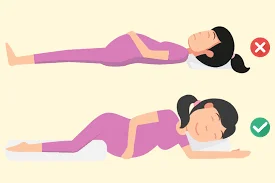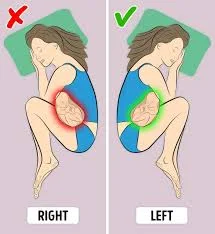The Best Sleeping Position During Pregnancy
Introduction
Pregnancy is a transformative and delicate period in a woman’s life, characterized by numerous physical and hormonal changes. Among the various factors contributing to a healthy pregnancy, sleep plays a crucial role in ensuring the well-being of both the expectant mother and the developing fetus.
Choosing the right sleeping position during pregnancy is a topic of considerable importance, as it can impact maternal comfort, alleviate potential discomforts, and promote optimal blood circulation.
Here’s everything you need to know to keep comfortable and safe.
Why is Sleeping so Important during Pregnancy?
Sleep is when your body resets and restores itself. It is when your brain forms memories, making it an ally in your fight against the baby brain. It is how your blood coronary arteries regenerate themselves, which is especially vital now because they are under higher pressure from the extra blood flow required to maintain your kid.
Sleep also helps to maintain the health of your immune system, which is reduced during pregnancy. Sleep affects how your body reacts to insulin; not getting sufficient sleep results in a higher blood sugar level, which increases your risk of gestational diabetes.
Which position is best for sleeping in while Pregnant?

Because it allows for the best circulation for both you and your unborn child, sleeping on your side, or “SOS,” is the best position to be in during pregnancy. Additionally, it stresses your veins and internal organs the least. The quantity of blood and nutrients that reach the placenta and your unborn child will increase if you sleep on your left side. Additionally, healthy circulation reduces the risk of hemorrhoids, varicose veins in the legs, and swelling.
Experts have typically advised that the greatest sleep position when pregnant is on your left side, however, your right is equally okay. Lying on your stomach becomes impossible after the first trimester for obvious reasons.
Many specialists also recommend that you avoid sleeping flat on your back all night. However, some doctors now believe that pregnant parents can sleep in any posture that is comfortable for them rather than worrying too much about it either way.
Sleeping on your stomach while pregnant

If tummy-down is your preferred position, that is fine until your baby bump makes it uncomfortable or impossible, at which point you must alter positions.
Sleeping on your back when pregnant

Sleeping on your back increases the risk of stillbirth in the third trimester (after 28 weeks of pregnancy), according to research. We advise sleeping on your side during the third trimester as it is safer for the unborn child, especially since the link has been demonstrated in six different research trials. The guidance applies to any sleep episode, such as:
- down during the day, going to sleep at night, and returning to sleep after any awakenings during the night.
- We don’t want this to cause you any anxiety. Your chance of having a stillbirth is minimal if your pregnancy is straightforward (1 in 200 babies are stillborn). It will be even lower if you sleep on your side.
- Some doctors suggest that pregnant women avoid sleeping on their backs throughout the second and third trimesters. Why? The back sleep position places the whole weight of the growing uterus and baby on your back, intestines, and vena cava, the main vein that returns blood from your lower body to the heart.
Previously, it had been suggested that laying on your side improved blood return to your heart and hence oxygenated blood delivery to your baby. However, some experts now believe that there is no significant difference in outcomes between babies born to mothers who sleep on their backs for a short time or for the majority of the time.
If you spoke with your provider and they recommended side sleeping for you, it’s best to follow their advice. Don’t worry if you wake up and discover that you’ve rolled onto your back overnight.
Sleeping on your left or right side while pregnant

Some doctors believe that sleeping on the Left side during the second and third trimesters, especially on the left, is best for you and your baby-to-be.
This posture provides for best blood flow and nutrition to the placenta (which implies less strain on the vena cava), and it improves renal function, which means better waste removal and decreased swelling in your hands, ankles, and feet.
Tips for comfortable pregnant sleeping positions
Are you not used to lying on your side? Or have you always been a side sleeper but find it difficult to get any sleep now that you’re expecting? Here are a few methods to address pregnancy sleep issues and get comfortable sleeping on your side:
- Use lots of cushions. Try crossing one leg over the other with a pillow between them and another behind your back, or any other sleeping position that works for you.
- Get a specialized pillow. For additional support, use a wedge-shaped pillow or a 5-foot full-body pregnant pillow.
- Lift yourself. If pillows don’t work, try sleeping in a semi-upright position in a chair (if you have one) instead of on your bed.
- Remember that it’s common to feel uncomfortable for a few nights or possibly weeks. Over time, your body will probably adapt to the new position.
Advice on how to sleep on your side when pregnant
- Pillows behind you will help you avoid putting on your back. Although it probably won’t stop you from lying on your back completely, it will probably make it more uncomfortable.
- It could be difficult to sleep on your back for an extended period if you have long hair, but consider wearing it in a low bun.
- Check your position and return to sleeping on your side if you wake up during the night for any reason.
- Pay the same attention to your sleeping position during the day as you would at night if you plan to take nights of sleep during the day.
What if I wake up in the middle of the night on my back?
Position before bed, not position during the night, has been the subject of research. Simply return to sleeping on your side if you wake up on your back.
Since we are unable to control our posture while we sleep, a big bump is probably going to make it difficult for you to stay on your back for extended periods at night. We also know that we spend the majority of the night in the position we take up when we go to sleep.
Which Sleep Positions Should I Avoid While Pregnant?
- Sleeping on your back can result in low blood pressure, breathing difficulties, digestive issues, hemorrhoids, low blood pressure, and decreased blood flow to both your baby and your heart. This is the result of your intestines and major blood vessels—the aorta and vena cava—being supported by your expanding abdomen.
- Sleeping on your stomach: As your pregnancy progresses, your belly expands and your breasts become more sensitive, which makes sleeping on your stomach uncomfortable. You might find it easier to sleep on your stomach if you use a pillow in the shape of a cookie with a hole in the middle.
- Lying down when suffering from Pelvic Girdle Pain (PGP) or Symphysis Pubis Dysfunction (SPD)
This can be complicated advice for women with SPD to follow. However, since this is what the research is related to, you mustn’t be lying flat on your back. - It would be great if you could figure out how to make yourself comfortable on your side, like by placing a pillow behind your back or in a V shape, and maybe one supporting your legs as well. Try to maintain your legs at the same level. It is likely to hurt if your upper leg dips down onto your lower leg, but you may find it more comfortable to sleep on your side if you keep them level with a pillow.
- Even without SPD/PGP, there is an important equilibrium to be struck between sleeping in the safest position and getting as much restful sleep as possible. This is especially difficult in late pregnancy.
What if you wake up lying on your back during pregnancy?
Very few people stay in the same posture all night. Don’t panic if you wake up sleeping on your back or stomach during pregnancy. No harm was done.
The fact that you awake in the first place is probably your pregnant body’s way of reminding you to change positions (and possibly go to the toilet again, another typical pregnancy sleep difficulty).
Is not getting enough sleep dangerous for both mother and baby?
The vast majority of women have difficulty sleeping, so don’t worry if you’re not getting as much quality sleep as you were before pregnancy. However, research has indicated that women who sleep for less than six hours per night may experience longer labor
The most important factor to consider is how you feel, not how many hours you spend lying in bed. If you’re not sleeping and are constantly fatigued beyond the normal exhaustion of pregnancy, you’re not getting enough sleep.
If you believe a lack of sleep is becoming a problem, consult your doctor. He or she can assist you in determining the source of your problem and developing strategies to help you get the rest you require.
C-sections require.
Untreated sleep apnea, in which breathing is disrupted repeatedly during the night, resulting in poor sleep and nocturnal waking, has been associated with pregnancy issues such as preeclampsia, gestational hypertension, and low birth weight. If you suspect you may have this problem, consult your doctor.
The higher risk of stillbirth could be caused by what?
It matters where you sleep during the third trimester. The weight of the womb and the baby presses against other organs in your body when you are on your back.
Although the specific cause of the elevated risk of stillbirth is unknown to researchers, the following factors are known to be possibly significant:
The main blood vessels supplying the uterus are compressed by the baby and womb when you sleep or lie on your back, which can limit the amount of oxygen and blood that reaches the baby and placenta.
Your discomfort could be caused by:
You might find yourself wriggling in bed during pregnancy in an attempt to get comfortable before dozing off. Your body undergoes several changes during pregnancy, so your usual sleeping positions may no longer be comfortable for you.
- Enlarged abdomen
- Back pain
- Heartburn
- Breathing difficulty insomnia
Additional Guidelines to Improve Your Sleep During Pregnancy
- Cut back on caffeine. Aim to avoid caffeine-containing tea or coffee after 3 p.m.
- Drink a lot of water. Throughout the day, sip a lot of water, but cut back a few hours before bed to avoid having to get out of bed to use the bathroom.
- Spend thirty minutes working out. Exercise improves your sleep quality, but avoid doing it four hours before bed.
- Soothing activities. You can unwind with a foot or shoulder massage or a warm bath.
- Calm sleeping quarters. It will be easier to fall asleep and stay asleep if your bedroom is cool, quiet, and dark at night.
Tips for Better Sleep:
- Make a regular sleep schedule and try your best to follow it.
- Create a calming nighttime routine.
- Determine that your bedroom is cool, quiet, and dark.
- Exercise regularly, but stay away from intense activities right before bed.
- Avoid consuming alcohol or caffeine right before bed.
- Consult your physician if you have any discomfort or difficulty falling asleep.
Conclusion
Sleep During Pregnancy:
Pregnancy is a wonderful journey filled with many delights and, let’s face it, some sleep difficulties. Up until now, finding the ideal sleeping position could have appeared like a unicorn hunt for food. This guide uses the power of strategic sleeping to lay out the keys to having a healthy pregnancy and restful nights.
Left Side Love: The Key to Peaceful Sleep
Investigations declared that sleeping on one’s left side is the best option for pregnant women. There are many advantages to this job for you and your child:
- Blood Flow Bonanza: Visualise blood flow as a highway. By sleeping on your left side, you can maintain optimal circulation to your uterus and baby by preventing traffic congestion. Better nutrition delivery and a contented, healthy baby are the results of this. (Image of a blood flow diagram with hearts and arrows indicating the best sleeping position)
- Organ Oasis: Sleeping on your back can compress your internal organs, making them uncomfortable and possibly impairing their ability to function. Sleeping on your left side releases this pressure, allowing your kidneys, liver, and other vital body parts the room they require to function properly.
- Decreased Risk Rumble: Research may indicate a connection between sleeping on one’s back and a higher chance of developing some pregnancy-related problems. Even though more study is required, sleeping on your left side can provide you peace of mind and a proactive approach to a healthy pregnancy.
Moving Past the Left and Accepting Your Comfort Zone
- Though your left side may be the star player, your comfort is outstanding! If you don’t feel comfortable doing traditional left-side snoozing, don’t be afraid to try something different.
- Right-Side Snuggle: The right side can be a good fallback if the left side just doesn’t work. Just keep in mind that the left side offers greater blood flow optimization than this position does.
- Pregnancy pillows are your greatest partners when it comes to improving your quality of sleep. For optimal comfort, use them to elevate your legs, support your back, and cradle your bump. Additionally, standard pillows can be arranged thoughtfully to provide focused support all through the night. (Picture of a pregnant lady using a pregnancy pillow while dozing on her left side)
- Pay Attention to Your Body: Forget about the sleep guidebook and pay attention to your body’s indications. Try a variety of positions and pillow arrangements until you discover your ideal sleeping environment.
Overcoming Sleep Issues: Heartburn to Hiccups
- Sleep disturbances are a common side effect of pregnancy, but worry not! Here are some pointers for overcoming typical barriers:
- Heartburn Havoc: You can prevent heartburn by eating smaller, more frequent meals before bed, drinking plenty of water, and using pillows to raise your upper body. If necessary, discuss safe remedies with your doctor.
- Leg Cramp Tragedy: Wearing supportive socks, drinking plenty of water, and stretching before bed can all help to lessen the unpleasant force of leg cramps. See your physician if the problems continue.
Give yourself enough sleep!
- Make Your Bedroom a Sleep Sanctuary: To make your bedroom a restful place to sleep, get some soft bedding, blackout curtains, and a noise machine.
- Maintain a Sleep Schedule: Even on the weekends, try to maintain regular sleep and wake times. This helps to keep your body’s natural sleep-wake cycle in place.
- Relaxation Rituals: To tell your body it’s time to wind down, incorporate peaceful activities like meditation, reading, or gentle yoga into your nightly schedule.
FAQs
I’m pregnant, but why does sleeping on my left side feel uncomfortable to me?
Sleeping On Your Left Side
Venous compression causes reduced blood flow throughout the body, including the uterus, and a slowed return of blood to the heart. Because of the change in blood flow, you may start to feel nauseous and light-headed, like someone is choking you or like you are about to pass out
I’m pregnant; can I lie on my right side?
Important lessons learned. When pregnant, experts advise sleeping on your side. Even though left-sided sleeping is better for blood flow and was previously advised by medical professionals, there is currently no evidence to support restricting right-sided sleeping.
Which sleeping positions are best to avoid when expecting?
Having a back sleep: Back pain, breathing issues, digestive issues, hemorrhaging, low blood pressure, and decreased blood flow to both your baby and your heart can all result from this. This is the result of your intestines and major blood vessels—the aorta and vena cava—being supported by your expanding abdomen.
Which way is the baby—left or right?
Left occiput anterior: The fetus is on the left side of the womb, with its head down and its back to the pregnant woman. Right occiput anterior: The fetus is on the right side of the womb, but the position is the same as it was above. Posterior: The back aligns with the pregnant person’s head, which is down.
How come I’m pregnant and can’t sleep on my right side?
During pregnancy, sleeping on the left side promotes blood flow, which guarantees that the baby and its important organs get oxygen and nutrients. Check the Source that they require. Additionally, this position reduces the chance of leg and ankle edema.
Why does sleeping on my right side feel more comfortable for me?
According to research, sleeping on one’s right side may lessen nervous system activity, which lowers blood pressure and heart rate. Some scientists believe that the aging-related inclination towards sleeping on one’s right side is a natural, heart-protective reaction.
Why not sleep on your right side instead of your left?
Since the stomach and its gastric juices stay lower than the esophagus when we sleep on the left side, heartburn and other digestive disturbances are less common.” He added that by avoiding placing too much pressure on the back, this sleeping position can help to relieve any back pain that may already be present.
Why does sleeping on my left side disturb me when I’m pregnant?
Taking a Left-Side Sleep
Venous compression causes reduced blood flow throughout the body, including the uterus, and a slowed return of blood to the heart. You might begin to feel queasy and dizzy due to the alteration in blood flow as if someone is strangling you or you’re going to weak.
Which positions are best to avoid when pregnant?
Avoid lying on your back as much as possible, especially in the later stages of pregnancy when your uterus’s weight may put pressure on your abdomen’s large blood vessels. When you’re on your side, avoid twisting and maintain a straight body posture with slightly bent knees.
References
- Sleep position in pregnancy Q&A. (n.d.). Tommy’s. https://www.tommys.org/pregnancy-information/im-pregnant/sleep-side/sleep-position-pregnancy-qa
- Best Sleeping Positions While Pregnant. (2023, December 7). American Pregnancy Association. https://americanpregnancy.org/healthy-pregnancy/pregnancy-health-wellness/sleeping-positions-while-pregnant/
- de Bellefonds, C., & de Bellefonds, C. (2023, April 24). Sleeping Positions During Pregnancy. What to Expect. https://www.whattoexpect.com/pregnancy/sleep-solutions/pregnancy-sleep-positions/







